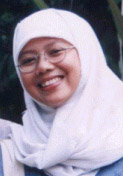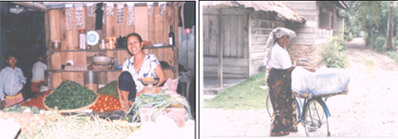Newsletter LEAD Cohort 9
SUCCESSFUL STORY ON GRAMEEN BANK REPLICATION
IN INDONESIA
Yulia Indawardhani, Program Director of YPM
 Muhammad Yunus - a professor in economy from University of Chittagong, Bangladesh - has found a brilliant idea for the best solution in helping the poor out of their poverty, which then grows over the world. It was initially begun in Jobra, Bangladesh and later on it is known as Grameen Bank, the largest bank in Bangladesh and probably the biggest micro credit organization in the world.
Muhammad Yunus - a professor in economy from University of Chittagong, Bangladesh - has found a brilliant idea for the best solution in helping the poor out of their poverty, which then grows over the world. It was initially begun in Jobra, Bangladesh and later on it is known as Grameen Bank, the largest bank in Bangladesh and probably the biggest micro credit organization in the world.
Grameen Bank provides micro credit to the poorest of the poor in rural Bangladesh without any collateral. At Grameen Bank, credit is a cost effective weapon to fight poverty and it serves as a catalyst in the overall development of socio-economic.
To date, Grameen Bank model has been replicated by 400 replicators in 22 countries of Africa, 19 in Asia, 3 in Oceania, 15 in the Americas, and 7 in Europe. This proves the successful of Grameen Bank as poverty alleviation program and has been internationally accepted by different countries and cultures. No wonder we get surprised by the achievement, mostly 100% repayment record with the improving of life quality - better meals, better education, and better house.
Grameen Bank Replication (GBR) program in Indonesia was initially projected in Bogor, West Java by Karya Usaha Mandiri (KUM) on 1989. Then Mitra Karya East Java (MKEJ) came up in Malang, East Java on 1993. Both organizations have pioneered the GBR story in Indonesia as over 15 GBRs has taken part in many parts of the country since 1997.
KUM, Bogor, West Java
KUM was firstly located in Nanggung Sub District, Bogor, West Java under the agreement of Agricultural Research and Development Board, Asia Pacific Development Centre, and Bank of Indonesia. Now, KUM has reached over 1485 members (100% women) in 33 villages of 3 Sub Districts. By July 2000, the total loan disbursement was Rp. 1,6 billion and total saving was Rp. 380 million.
The repayment rate, which closes to 100%, proves that the poor is apparently bankable. Credit is usually used as additional capital for their enterprises, whether belong to their husbands or themselves. For the poor, KUM has broaden the opportunity for women to access capital fund. This means that instead of being a mother-wife, woman also has taken their role in family income generating. By increasing the capital, they develop their enterprises, income grows, and later on improving their life quality with more assets and welfare.
After all those efforts, 35.29 % of KUM members get improvement on their food consumption, 32.35 % on clothes, 47.06 % on education and 58.82 % has increased assets and investments. Relating with assets, 382 members shows the increasing of assets value 31.6 % per annum for 5 years membership period. In education, their monthly expenditure is amazingly increased to 10.3 % per annum.
These facts shows us how GBR works on poverty fighting by assisting the poor in income generating and improving their life quality.
MKEJ, Malang, East Java
By September 2000, Mitra Karya East Java (MKEJ) operates 6 branches in 2 Regencies (Malang and Blitar) that covers 50 villages with 8.300 poor family members. Total loan disbursement is Rp. 2,1 billion, and total Group Saving is Rp. 340 million. All MKEJ members are women.
MKEJ reports that after 1-year membership, 80% members will be improved in their family income, which is about 30% - 100% increasing rate.
YPM, Medan, North Sumatra
In Sumatra, Grameen Bank model is initially replicated by Yayasan Pokmas Mandiri (YPM). Since January 2000, YPM has taken place for their pilot project in Deli Serdang Regency, North Sumatra Province.
During 2000, the project has presented a great achievement in helping the poor out of poverty. All YPM members are women who own micro-scale businesses. By accessing micro credit, they may improve their businesses and get more incomes. It is true that poverty can not be alleviated only in one or two years, but these monthly achievement indicates the objectives optimistly.
One of the indicators is their improvement in family incomes. We might feel excited with the average 56% increasing in daily omzet which also impacts their annual income.
Now YPM has 2 branches in 2 regencies (Deli Serdang and Asahan) that covers over 60 villages and totally operates as a sustainable micro-credit organization. After 2 years, YPM has reached over 700 members and disburse Rp. 320 million as micro-loan with 100% repayment rate.
GBR Prospect in Indonesia
There are many people in Sumatra and elsewhere who have the idea of helping the poor. They too want to help the poor: some build mosques and churches, young doctors open free clinics, teachers teach for the love of it, the government builds roads and bridges, water supplies and toilets to help the poor. In general however most efforts to help the poor are charity and the poor stay poor.
Grameen Banking puts the poor on the same level with them. There is no charity, but it grows dignity. The poor is, in fact, a potential client to be assisted and trusted. The features of GB and GBRs had disclosed the facts and expectedly bring us to a better step in overcoming poverty.

Micro-scale business with micro credit assistance,
helping the poor out of their poverty
References:
1. Champion, Ibrahim. Starting-up YPM A Grameen Bank Replica in Northern Sumatra (A paper on Micro Credit Workshop). Jakarta 2000.
2. Sulistyowati, Ani. Kredit Mikro dengan Pendekatan Grameen Bank, Replikasi di Indonesia dan Beberapa Negara. YPM and ELLSPAT. Jakarta 2000.
3. Syukur, Mat and Murtadho. KUM, Usaha Memberdayakan Masyarakat Miskin Melalui Bantuan Kredit. (A paper on Micro Credit Workshop). Jakarta 2000.
.***